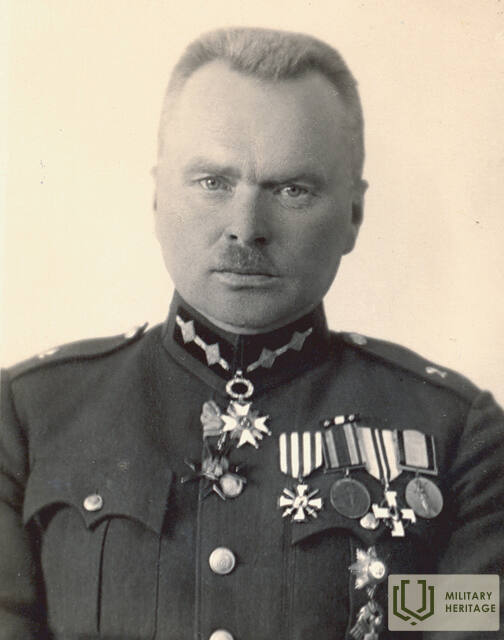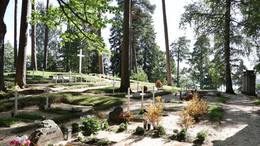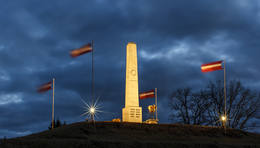Atminimo akimirka Garisono kapinėse
Atkūrus Latvijos nepriklausomybę, Alūksnės brolių kapinių komiteto vadovas Uldis Veldre ėmėsi rūpintis Garnizono kapinių priežiūra, nustatyti su Alūksne susijusias LKOK poilsio vietas ir įrengti atminimo ženklus Garnizono kapinėse.
„Kai sužinojau, kad mirė V. Spandegs (1890–1941), 1990 m. gruodžio 19 d., sovietinės okupacijos sąlygomis, Alūksnės garnizono kapinėse prie didelio balto kryžiaus, surengiau jo 100-ojo gimtadienio minėjimą, atidengdamas ten esančią balto marmuro Lāčplėsio atminimo lentą. Šalia šios atminimo lentos visada yra šviežių gėlių, ji kruopščiai valoma, ypač pažymime generolo V. Spandego gimimo ir mirties datas – gruodžio 19 d., spalio 16 d. ir Lāčplėsio dieną – lapkričio 11 d. Taip pat spalio 16 d. minėjome Lāčplėsio Vilio Spandego 60-ąsias mirties metines. Garbės sargyboje su Latvijos vėliava ir bataliono vėliava stovėjo drąsūs tėvynės gynėjai – Alūksnės mobiliojo šaulių bataliono (MBS) kariai, E. Gliko Alūksnės valstybinės gimnazijos vėliavnešiai. 1938 m. vėliava – 7-ojo Siguldos pulko dovana...“ Pėstininkų pulko į Alūksnės valstybinę gimnaziją – įteikė pulkininkas Vilis Spandegs. Tėvynės meilės pamokos pabaigoje mūsų nacionalinio didvyrio šeima – Lāčplēsis Vilis Spandegs, Alūksnės brolių kapinių komitetas, Alūksnės MSB, Lāčplēsis Eduardas
Koklės anūkas Sandris, proanūkis Albertas ir proanūkė Adelė Līviņi pasodino ąžuolą, kad amžinai gyvuotų šviesus paskutiniojo 7-ojo Siguldos pėstininkų pulko vado, Lačplėsio kapo ordino kavalieriaus, tuometinio pulkininko Vilio Spandego, atminimas. Ąžuolą parsivežėme kartu su MSB vaikinais iš didžiojo latvio Zigfrīdo Kalačio žemės. Pasirinkimas nebuvo atsitiktinis. 1919 metų ankstyvą pavasarį, per mūšius prie Rezakos, Jaunlaicenės, Apės, antrajam Valmieros pulko batalionui vadovavo mūsų vietinis (iš Gaujės) Kārlis Bojārs - Lačplėsio kapo ordino 3-iosios klasės kavalierius, 7-ojo Siguldos pėstininkų pulko vadas iki pulkininko V. Spandego atvykimo į Alūksnę 1936 metais. Didvyriai nemiršta. Jie gyvens mūsų žmonių širdyse net ir tada, kai mano karta – tikroji Alūksnės ir Latvijos istorijos nešėja prieš daugiau nei 60 metų – iškeliaus iš mirties. Tegul niekada netrūksta didvyrių, kurie gali ir nori atiduoti viską, ką turi, už savo tėvynę, savo šalį ir savo žmones.“
Uldis Veldre, Alūksnės brolių kapinių komiteto vadovas. Alūksnė mini Vili Spandegą. Pasakojimai apie Lāčplėšius. Laisvoji Latvija: bendras „Londono laikraštis“ ir „Latvija“, 2001, lapkričio 10 d., Nr.43.
https://www.youtube.com/watch?v=jtzCjhm80so
Susijusi laiko juosta
Susijusios vietos
Alūksnės įgulos kapinės
Įsikūręs Alūksnės ežero pakrantėje, Kapsėtos pusiasalyje, Didžiųjų kapinių teritorijoje.
Jie pradėti kurti ir prižiūrėti 7-ojo Siguldos pėstininkų pulko karių rūpesčiu XX a. 4-ajame dešimtmetyje ir pašventinti 1932 m. lapkričio 11 d. Atkūrus Latvijos nepriklausomybę, Garnizono kapinių priežiūros, su Alūksne susijusių LKOK poilsio vietų nustatymo ir atminimo ženklų Garnizono kapinėse įrengimo ėmėsi Alūksnės brolių kapinių komiteto skyriaus vedėjas Uldis Veldre.
Garnizono kapinėse palaidoti Latvijos Respublikos armijos kariškiai, taip pat kareiviai ir civiliai, žuvę kovose su bolševikais 1941 m. liepos 4 d. Alūksnėje prie Jāņkalninio ir 1941 m. liepos 7 d. Ziemerso valsčiuje prie Prindulių namų.
Daugumoje palaidotųjų yra balti mediniai kryžiai su metalinėmis lentelėmis, kuriose nurodytas mirusiojo vardas, pavardė, rangas ar profesija, taip pat gimimo ir mirties datos.
1990 m. gruodžio 19 d. Garnizono kapinėse buvo atidengta atminimo lenta Lačplėšio karo ordino kavalieriui Viliui Spandegui. Tipinės atminimo lentos taip pat buvo įrengtos LKOK nariams, žuvusiems arba nužudytiems komunistinėse koncentracijos stovyklose ir nepalaidotiems Latvijoje. 1990 m. lapkričio 11 d. buvo įrengta atminimo lenta LKOK nariui Voldemarui Zakiui, žuvusiam komunistinėje koncentracijos stovykloje.
Paminklas 7-ojo Siguldos pėstininkų pulko kariams, žuvusiems Latvijos Nepriklausomybės kare
Įsikūręs Alūksnės ežero pakrantėje, Pskevo (Kolbergo) gatvės pusėje.
1923 metų birželio 22 dieną Latvijos prezidentas Jānis Čakste atidengė paminklą žuvusiems 7-ojo Siguldos pėstininkų pulko kariams. Paminklą sukūrė dailininkas Jūlijs Miesnieks.
Pulko kariai taip pat gerino ir tvarkė paminklo aplinką. Kareiviai prie paminklo rinkosi pulko metinių minėjimo išvakarėse, kai uždegdavo šventąją ugnį, taip pat pulko metinių dieną po parado ir užtarimo Garnizono kapinėse.
1940/1941 m. bolševikai pašalino ir sunaikino lentą, tačiau pats paminklas buvo nugriautas 1953 m., o jo akmenys įmūryti į kareivinių pastato kampinius pamatus.
Prasidėjus Atbudimui, 1989 m. rudenį buvo sutvarkyta teritorija aplink sunaikintą paminklą, kuris tuo metu dar buvo SSRS okupacinių kariuomenės teritorijoje. Lapkričio 11 d. buvusioje paminklo vietoje buvo atidengtas laikinas granito memorialas su išgraviruotu tekstu: „7-ojo Siguldos pėstininkų pulko paminklas šioje vietoje bus atkurtas 1989 m. lapkričio 11 d.“
Alūksnės brolių kapinių komiteto vadovo U. Veldre iniciatyva buvo pradėti paminklo restauravimo darbai, o restauruotas paminklas atidengtas 2009 m. spalio 16 d.
Skirtingai nuo originalaus paminklo, ant obelisko vietoj pulko krūtinės šarvų buvo sukurtas kryžius. Abu paminklo reljefus nukalė skulptorius Ainārs Zelčs. Restauruotam paminklui panaudotos tiek 22 originalių obelisko blokų dalys, rastos Nacionalinių ginkluotųjų pajėgų pėstininkų mokyklos teritorijoje, tiek naujai pagaminti blokai.
2019 m. birželio 20 d., minint 7-ojo Siguldos pėstininkų pulko šimtmečio jubiliejų, paminklo kalnelio papėdėje buvo atidengta pulko paminklo atminimo vieta ir granito atminimo lenta žuvusiems dalinio kariams, ant kurios išgraviruotas tekstas: „Jūsų stipri dvasia visada su mumis...“. Atminimo vieta pastatyta Nacionalinių ginkluotųjų pajėgų Pėstininkų mokyklos personalo paaukotomis lėšomis.







